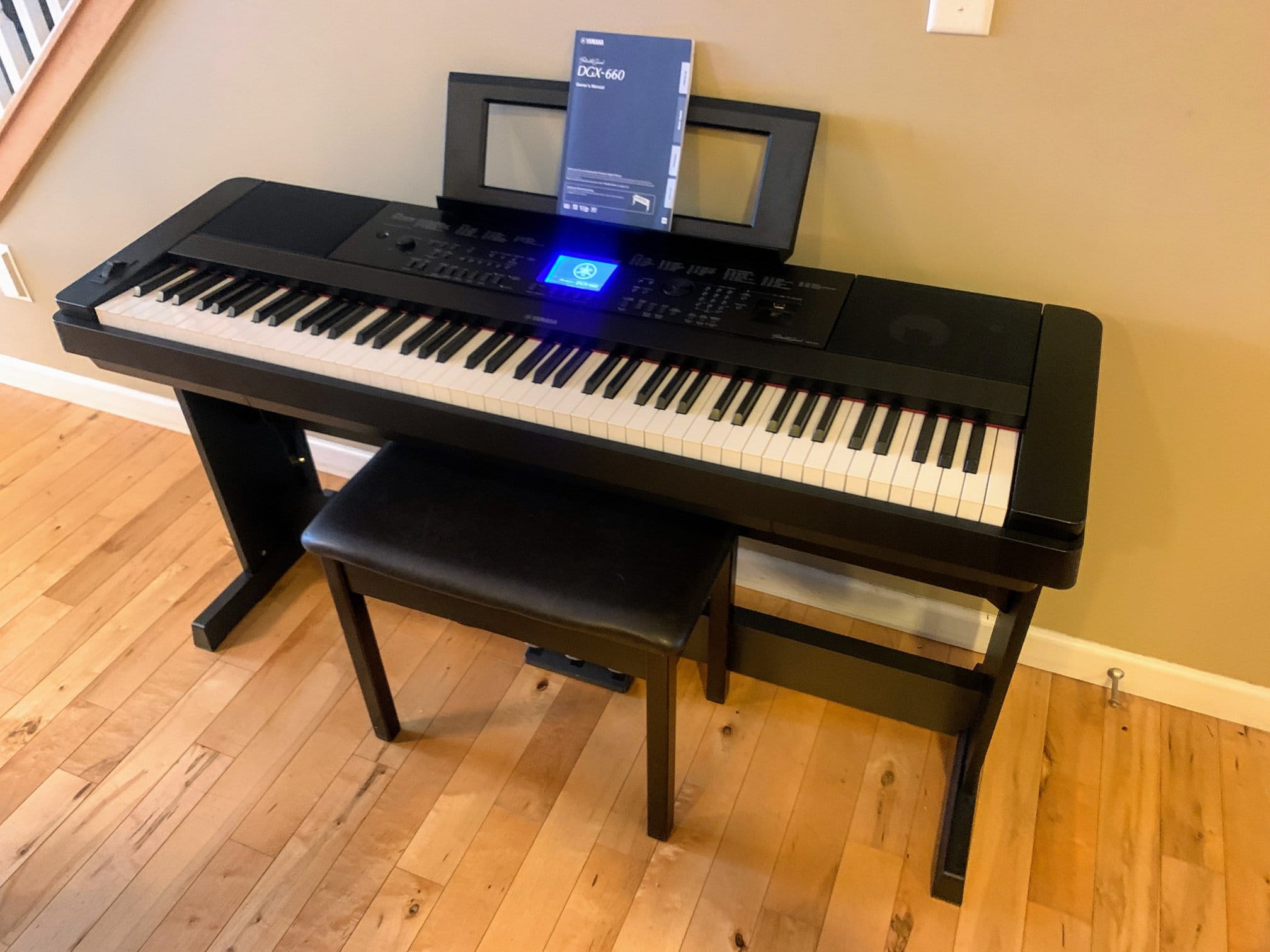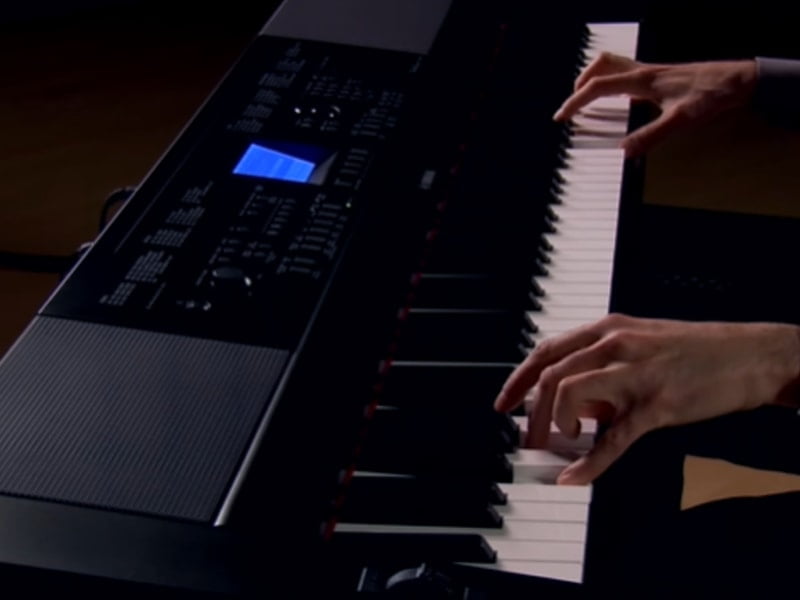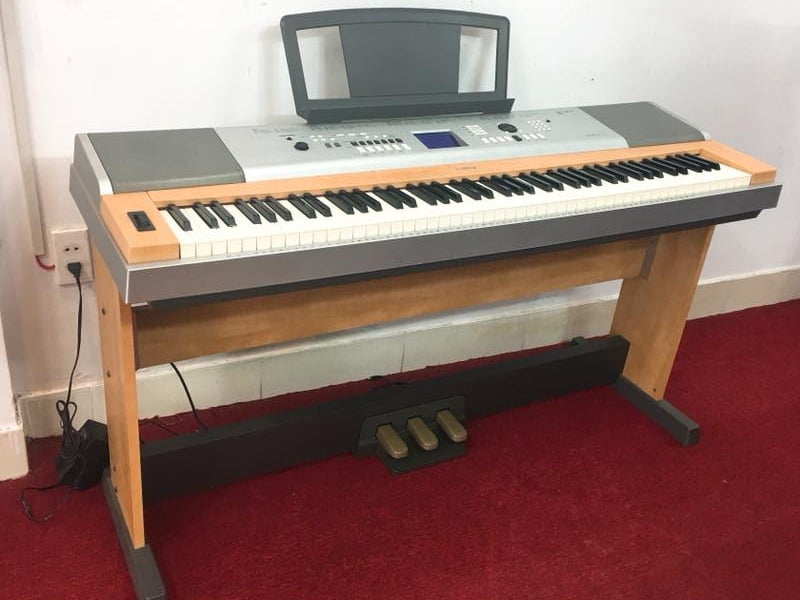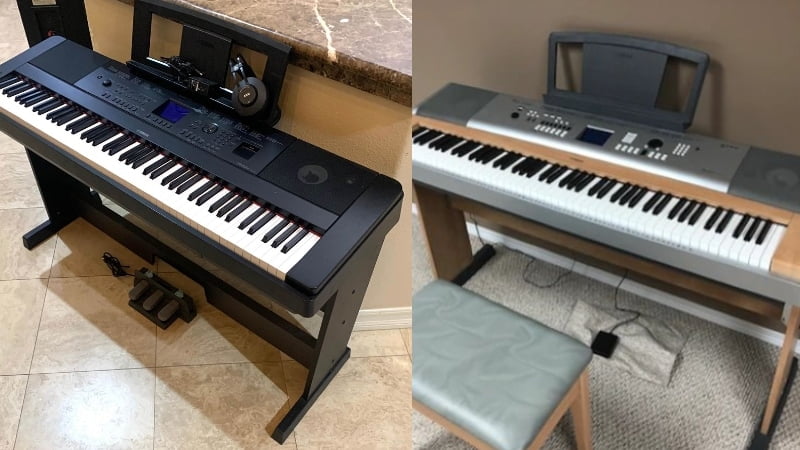Find out which piano is the best investment for you in this Yamaha DGX-660 vs DGX-630 comparison!
If you need a high-quality digital piano that comes with many voices and great features, Yamaha’s DGX series is a great option for you. This product line boasts some of the best Yamaha digital pianos on the market, and on top of that, they won’t even cost you that much.
And if you’re shopping within this collection, the DGX-660 and the DGX-630 are great picks. The DGX-630 is one of the more affordable DGX models, so you don’t get all the features, but you will save some money. The DGX-660, on the other hand, is one of the more premium options in this line, so it’s more expensive but comes with more features.
I decided to compare these models against each other. And while it was a pretty close fight, the DGX-660 came out on top. Below, I’ll get into the details of this Yamaha DGX-660 vs DGX-630 comparison, so you’ll know exactly why and how the Yamaha DGX-660 won out.
Below, I’ll show you the features, benefits, and drawbacks of both pianos. So by the end of this comparison, you have a full picture and will have a much easier time determining which piano is best suited to your needs!
Yamaha DGX-660 vs DGX-630: Comparison Chart




Last update on 2025-07-06 / Affiliate links / Images from Amazon Product Advertising API
Yamaha DGX-660 vs DGX-630: A Head-to-Head Comparison
When I looked at the features of both of these pianos, the DGX-660 was an easy winner. For this comparison, I judged the instruments based on the tone, feel, and polyphony of the pianos. The DGX-660 won all of these comparison points, and the final score was 3-0.
But just because the DGX-630 couldn’t steal a point from the DGX-660 doesn’t mean it isn’t a good piano. Below, I’ll detail how I tested and judged these pianos, so you get a clearer picture of which one fits your preferences better.
Tone
The winner: Yamaha DGX-660
One of the most distinctive features of Yamaha digital pianos is its amazing tone. These pianos are known for producing a sound that’s very close to a real acoustic piano. And while both the DGX-630 and 660 do a great job of replicating the tone of an acoustic piano, the DGX-660 does it much better.
On top of that, it’s equipped with a wide array of voices and tones that you can use for different genres and musical styles. So, not only does the DGX-660 beat out the 630 when it comes to quality, but it wins in terms of quality as well, which is why it won this first point.

+Tone Generation
The first thing to look at when judging a digital piano’s tone is the tone generator or tone engine. Both of these pianos use a sample-based tone engine. But while the DGX-630 uses generic Yamaha samples, the DGX-660 derives its samples from Yamaha CF Grand Pianos.
Don’t get me wrong; there’s nothing wrong with how the DGX-630 sounds. In fact, it’s one of the most realistic options in its price range. However, the DGX-660 brings the tone to another level with its top-quality samples that are full of detail.
Since the samples are of higher quality on the DGX-660, you get a crisper and brighter tone. Now, if you aren’t a fan of how Yamaha CF Grand Pianos sound, this might not be your option. But if you’re looking for a piano with bright piano tones that truly shine, this is a great option.
On top of that, the DGX-660 uses the XGlLite Suite for some of its other tones. This isn’t the most realistic sound bank, but it contains interesting sounds. This is why I consider the Yamaha DGX-660 to be one of the best gig-ready digital pianos you’ll be able to get your hands on.
+Sound Library
The Yamaha DGX-630’s sound library is no joke. While the tones aren’t as crisp or clear as the DGX-660, it makes up for it with a library of over 500 different voices. This allows you to play just about any musical genre out there. Whether you need a piano tone for classical music, an organ for modern jams, or even a synth when playing in a band, the DGX-630 has covered you.
But since the DGX-660 is a step above the DGX-630, the former comes with an even larger sound library. The DGX-660 comes with over 550 different voices. So, aside from various instruments, you can even play drum sounds and SFX on this piano, making it a much more versatile option.
For many modern pianists, sound variety is very important. This is why I consider the Yamaha DGX-660 one of the best modern options in its price range. This is because even if some of the tones aren’t as realistic as I’d want them to be, it’s really nice having a bunch of sounds available when playing with other musicians.
Feel
The winner: Yamaha DGX-660
The second-most important feature of a digital piano is the feel. Again, you want to get a model that replicates the feeling of playing an acoustic piano. And while no digital instrument can do this perfectly, the Yamaha DGX-660 does a very good job. In fact, even if the DGX-630 had an impressive hammer action system, it couldn’t compare with that of the DGX-660.
So, yet again, the Yamaha DGX-660 comes away with the point.

+Hammer Action
If you’re a beginner, I’d highly recommend getting the DGX-630. Not only is it affordable, but it comes with fully-weighted keys. There are many options in this price range that only come with soft-touch or semi-weighted keys, which makes it much harder to jump between a digital and acoustic piano.
But since the DGX-630 has fully-weighted keys, it feels pretty close to an acoustic piano. This not only helps your fingers get used to a heavier hammer action, but it also allows you to add more expression and emotion to your playing.
That said, if you’re looking for an added layer of realism, the DGX-660 has exactly what you need. This piano comes with Yamaha’s Graded Hammer Standard or GHS system. This type of hammer action features heavier bass keys and lighter treble keys.
The reason this feature is so good is that acoustic pianos don’t have a uniform weight. If you try out any acoustic piano right now, you’ll notice that the left side of the piano has a bit more weight. This isn’t something that many beginners notice, but most experienced pianists will tell you that this weight difference is very important.
Not only does the DGX-660 have a much better hammer action system, but it even has textured black keys. The coating on the black keys is meant to resemble ebony, which makes the piano feel even more realistic. So, there was no doubt in my mind that the Yamaha DGX-660 has a much more realistic feel compared to the DGX–630.
Polyphony
The winner: Yamaha DGX-660
The Yamaha DGX-660 comes with 192-note polyphony while the DGX-630 only comes with 64-note polyphony. Polyphony is very important as it is the piano’s ability to play notes and sounds simultaneous. And since the DGX-660 has higher polyphony, it can handle more notes at the same time.
Now, you might be thinking about when you will need to play 192 notes at the same time if the piano only has 88 keys. So, let me explain.
When you start to play more advanced pieces, you will notice that there are times when you must press the sustain pedal. This allows notes to ring out longer. But if you keep playing while holding the sustain pedal, then the piano has to sustain all those notes simultaneously.
Another example of when you need high polyphony is when you use dual mode. This mode allows you to blend different voices together. And when you do this, you play multiple sounds whenever you press a key. So, having a higher polyphony allows you to freely explore note combinations regardless of what mode you’re using.
Again, the Yamaha DGX-660 is much more expensive than the DGX-630. And while this isn’t good for people on a budget, the extra cost means that it comes with way more features that you may find useful as a pianist.

Yamaha DGX-660 vs DGX-630: The Similarities
The Yamaha DGX-660 and the DGX-630 come from the exact same product line. And while there are many differences between the two, there are also quite a few similarities. There are a couple of key characteristics of DGX pianos that are present in all their models.
For example, both pianos are equipped with massive sound libraries. This means you have a lot of versatility and freedom to play various sounds and musical styles. On top of that, the different playing modes on the piano allow you to experiment with new sounds, which is important when starting your musical journey.
Another similarity is the fact that these are portable pianos. The DGX series contains portable grand pianos, meaning that these instruments have top-quality sounds while also being easy to bring around, making them some of the best options for gigging musicians.
While the DGX-660 won this comparison on all bases, that doesn’t mean the DGX-630 is a bad option. These are both great pianos that will serve you well. However, if you’re looking for more versatility, then you might want to consider spending a bit more money on the DGX-660.
Quick Rundown of the Yamaha DGX-660
- The Pure CF Sound Engine faithfully reproduces the tone of a meticulously sampled and highly acclaimed Yamaha concert grand piano
- GHS weighted action is heavier in the low register and lighter in the high, just like an acoustic piano
- Score display puts music notation of MIDI songs on the screen, helping you play your favorites by following the bouncing ball
- The Piano room lets you choose from a variety of pianos and acoustic settings to create your own personal piano environment
- The 6 track recorder allows you to capture your performances and song ideas, then add additional layers to spice up your pieces
Last update on 2025-07-06 / Affiliate links / Images from Amazon Product Advertising API
Quick Rundown of the Yamaha DGX-630
- 88 Piano style, weighted keys with Graded Soft Touch
- 6-track recorder
- DSP effects for more realistic sounding Distortion Guitar and Rotary Organ
- 503 high-quality tones
- Stereo Speakers
Last update on 2025-07-05 / Affiliate links / Images from Amazon Product Advertising API
Product Video
Related Articles to Yamaha Dgx 660
- Yamaha YDP-164 vs DGX-660: Why You Should Go for the DGX-660
- Yamaha DGX-660 vs Roland FP-90: Why the Roland FP-90 Is the Better Pick
- Yamaha DGX-530 vs 660: Why the DGX-660 Is the Better Pick
- Yamaha DGX-505 vs 660: Why the DGX-660 Is the Better Pick
- Yamaha DGX-660 vs DGX-640: A DGX Comparison
- Yamaha DGX-620 vs 660: Finding the Best DGX Model
- Yamaha DGX-660 vs YDP-163: Which Is the Better Piano?
- Yamaha DGX-660 vs Roland Juno DS-88: Which Is the Better Piano?
- Yamaha DGX-660 vs Casio PX-360: Which Is the Better Piano?
- Yamaha DGX-660 vs YDP-144: Which Is the Better Yamaha Piano?
- Yamaha DGX-660 vs Korg Havian 30: Which Is the Better Digital Piano?
- Yamaha DGX-660 vs Casio CGP-700: Which Is the Better Pick?
- Yamaha DGX-660 vs YPG-535: Finding the Best Yamaha Digital Piano
- Yamaha DGX-660 vs P515: Is the P515 Worth the Extra Cost?
- Yamaha DGX-660 vs P-115: Which Yamaha Model Is Better?
- Yamaha DGX-660 vs Casio PX-560: Which Piano Offers More Value For The Money
- Yamaha DGX-660 vs 650: A DGX Comparison
- Korg XE-20 vs Yamaha DGX-660: Finding the Best Digital Piano
- Yamaha P45 Vs DGX-660: A Head-to-Head Comparison
- Yamaha DGX 670 Vs 660: The Distinct Difference In Details You Need To Know About
- Yamaha YDP-103 Vs DGX-660: Which Is The Better Yamaha Piano?
- Casio PX-770 Vs Yamaha DGX-660: Should You Get A Portable Or Console Digital Piano?
- Yamaha P71 vs DGX-660: Can the Amazon Exclusive Beat Out the Premium Model?
- Yamaha P125 vs DGX 660 Comparison: Can the P125 Hold Its Own Against the DGX 660?
References:
- Yamaha DGX-660: https://usa.yamaha.com/products/musical_instruments/pianos/p_series/dgx-660/index.html
- Yamaha DGX-630: https://productz.com/en/yamaha-dgx-630/p/yMQL
Lulacruza is an electronic folk duo operating at the junction of the hypermodern and the ancient. Our music weaves together hypnotic female singing, South American folk instruments and electronic processing, while channeling pulsating waves from the source of creation.
Lalucruza is also a community where you can connect with other music lovers to collaborate, exchange ideas and share knowledge. A platform for who wants to learns the basics of playing piano, guitar, drum masters’ technique, etc.. is the premise of our website.
